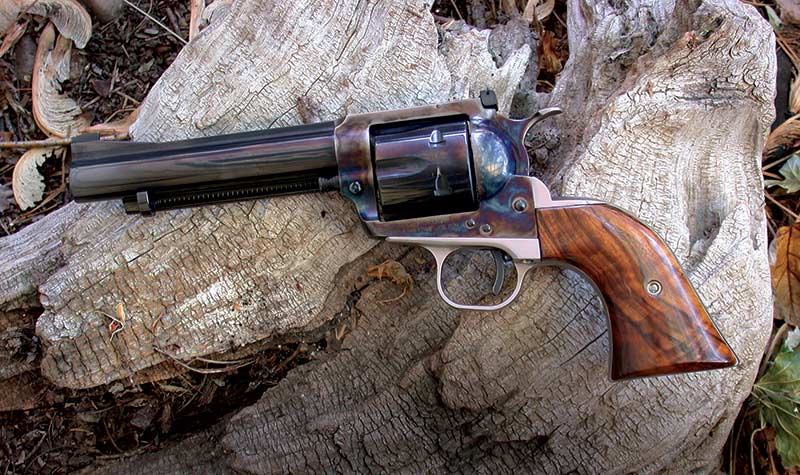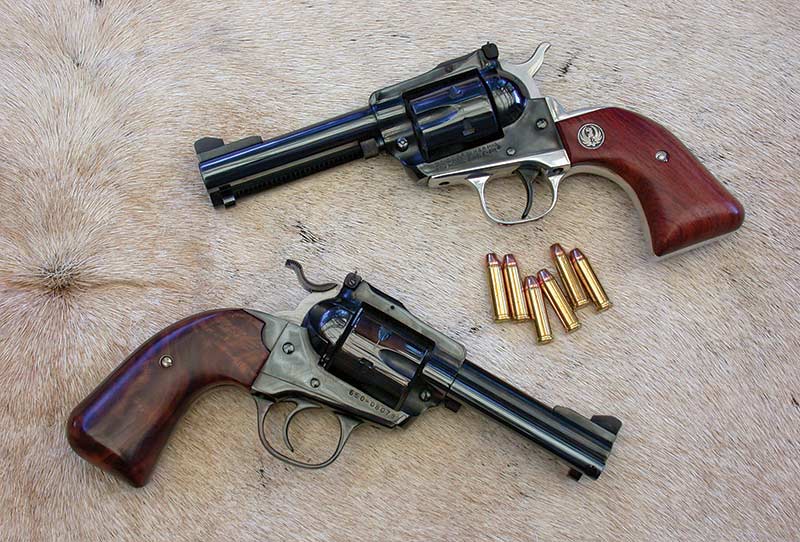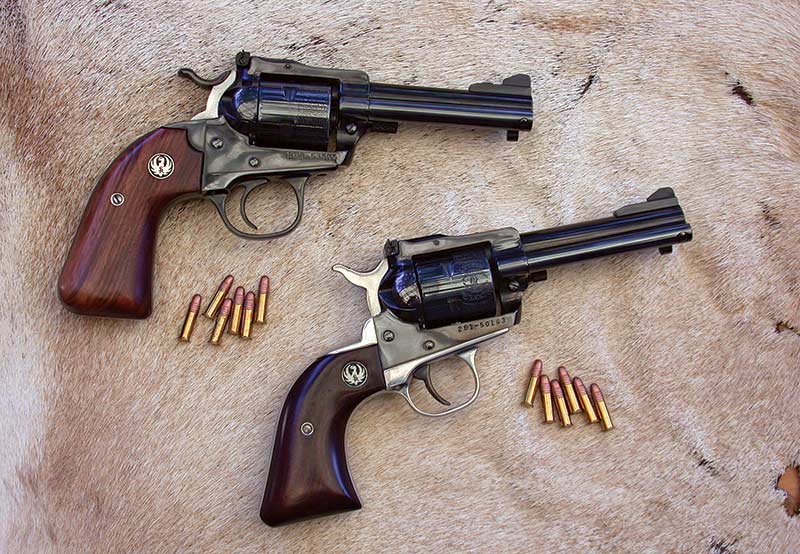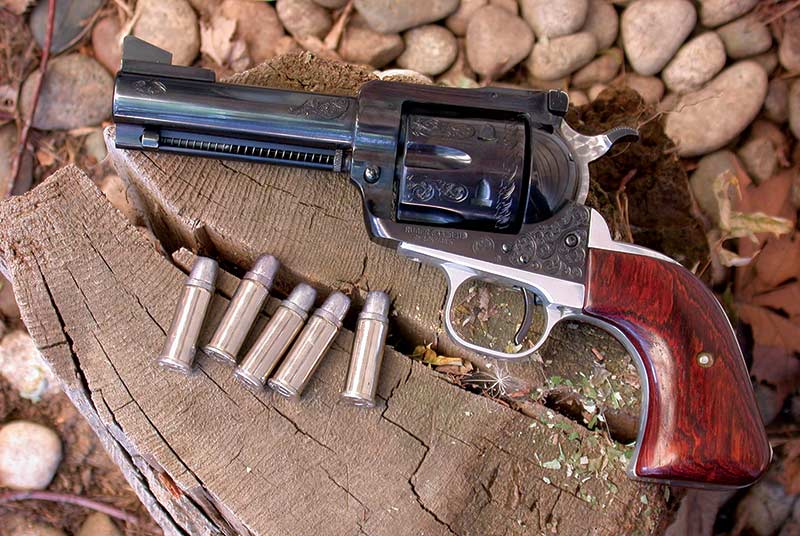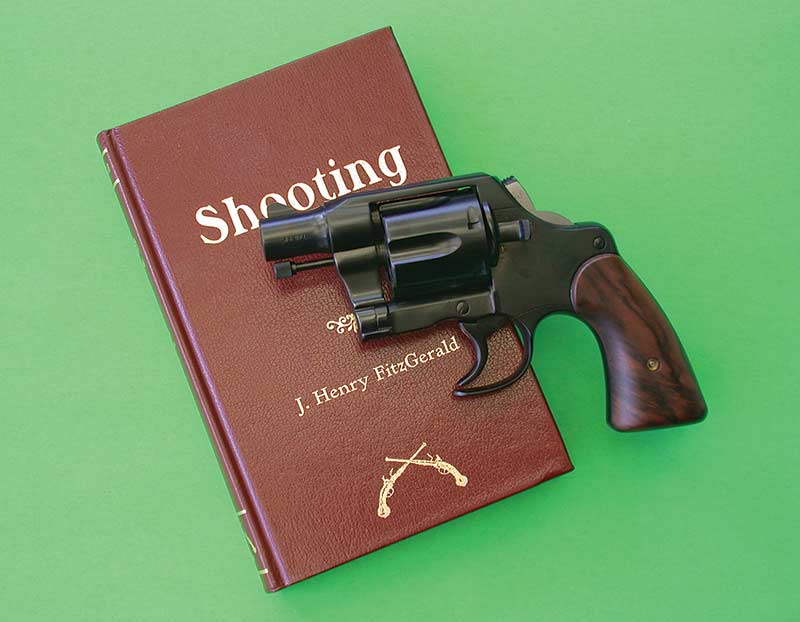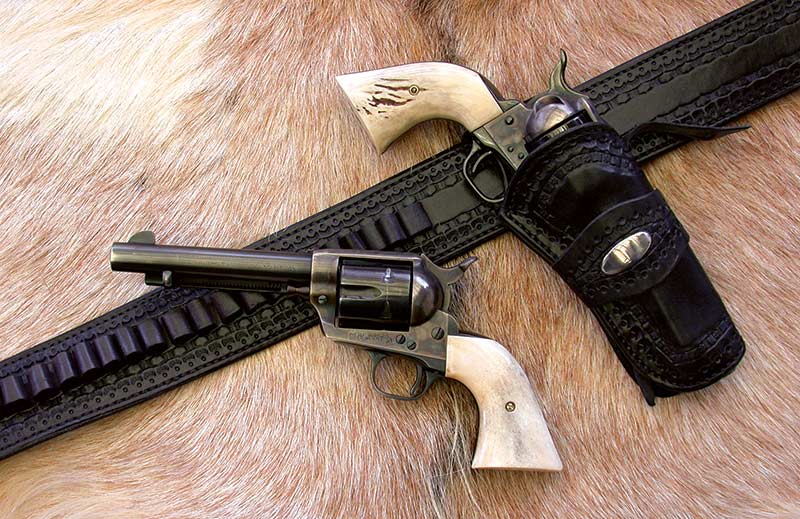The Sixguns Of Andy Horvath
The three of us were sitting in the front seat of a pickup looking out over a large field on the Idaho/Nevada border hoping to spot squeakies. These little ground squirrels are also known as picket-pins around here and they exist by the millions, mostly in the sagebrush and farming areas. We were on a Winchester-sponsored varmint hunt and the long-range scoped rifles and pistols had been put away and we had switched to the more sporting open-sighted revolvers.
If I remember correctly Rod Herrett was using a S&W K-22, Clair Rees had a semiauto Browning, and I had my Andy Horvath custom L’il Gun, a .22 Single-Six. The action had slowed down considerably and I asked the other fellows to spot for me as I shot at some rocks on a dirt bank. I managed to connect on one and when they put the rangefinder on it the reading was 181 yards. “If a squeaky comes out on that bank I will try to take him.” A few minutes later I was holding up what I considered to be the correct amount of front sight and squeezing the trigger on one of the little squirrels, smaller than a pop can. It was probably the best shot I have ever made and ever will. Andy’s Horvath’s L’il Gun made me look awfully good and I was smart enough to put that gun away and not use it the rest of the trip.
The First L’il Gun
Way back in the early 1980s I spotted a very small 1″ ad in J.D.’s HHI club paper. It simply read “.44 Specials Custom Built.” Not believing in either accidents or coincidences, I knew I was meant to see it and respond. Calling Andy Horvath resulted in his sending three samples of his specially crafted .44 Specials: two sixguns and a Model ’92 Winchester he had rescued from the bone pile. The two sixguns were a Ruger Old Model .357 Blackhawk and a S&W Highway Patrolman .357, Magnum both of which had been given new life as .44 Specials. I was impressed enough I sent off an Old Model Ruger .357 to be made into a .44 Special. Instead of the standard version with a 45⁄8″ barrel and regular grip frame, I had him cut both barrel and ejector rod to 4” and slightly roundbutt the grip frame. In addition he tuned the action and provided a beautiful deep dark blue job. That was the first L’il Gun but not the last.
That little .44 Special was one of the sixguns I took to the first Shootist Holiday in 1986. I showed it to two of the premier gunsmiths who were there, Dick Casull and John Linebaugh, and they were both highly impressed with the quality of Andy’s work. He was about to become well-known among sixgunners around the country. This gun started a long line of L’il Rugers by Horvath and I borrowed several others in both blue and stainless versions as well as .45 Colt and .41 Magnum chamberings and wrote about them in the Sep/Oct 1990 issue of American Handgunner. Andy credits me with keeping him busy ever since.
Hollywood Calling
Shortly after that article appeared I received a call one evening from Hollywood. One or both of the stars for an upcoming movie had seen the article and wanted to borrow my Horvath .44 Special sixgun for the movie. By now this first L’il Gun had been engraved and since I had seen many times how Hollywood treats firearms and not wanting what was now a prized possession to be beat up, I declined the sending of my .44, however I did put them in touch with Andy. As a result, he made several guns for the movie as well as for the two male leads. The title of the movie is best forgotten. I went to see it just to see Andy’s L’il Gun; there were only two of us in the theater, myself and a movie reviewer.
Down-Sizing
If the L’il Gun treatment is grand for .44s, it’s even more appropriate for smaller guns such as the Ruger Single-Six. Both the Single-Six and Bisley Model have been offered in a .22 LR and .32 Magnum, both of which are excellent candidates for small-sized Trail Guns. There are times when we prefer to go lightly on the trail and a smallish .22 or .32 is not only all we need, it’s probably the best choice. There are way too many folks who believe once they step off the pavement they are immediately subject to bear and mountain lion attacks. I even heard from one fellow who was planning to move to Idaho and wanted to trade in his .44 Magnum for a larger gun capable of handling bears. I certainly don’t know how large and ferocious he believes bears are in Idaho but a .44 Magnum is more than enough gun.
There are areas such as Alaska and a few wilderness pockets in the lower 48 where grizzlies roam and even places where wolves have become a problem. But for 99 percent of our traveling in sagebrush, forest, or mountains — and even though a .44 or .45 sixgun is almighty comforting — a
small pocket pistol is more than adequate. In addition to the gun being smallish, it’s possible to carry more ammunition, especially of the .22 LR and .22 Magnum variety, without being burdened down by excess weight. A couple of boxes of .22s take up very little space and add little weight to a backpack.
Perfect Trail Guns
With all this in mind I gathered two Ruger Single-Sixes, one a .22 Bisley and the other a .32 Magnum Single-Six, both with adjustable sights (I cannot see any reason not to have adjustable sights on a Trail Gun). Both guns went to Andy’s Diagonal Rd. Gun Shop and were given the full treatment of slightly round-butted grip frames, barrels and ejector housings cut to 4″, actions tuned, triggers cleaned up and finished in very beautiful blue jobs. I also asked Andy to switch grip frames so the .22 would be a standard model with a polished aluminum grip frame while the
blued steel Bisley grip frame was to go on the .32 Magnum. I did this, as I figured the .22 version would be the most used and I wanted it as light and compact as possible. It was this little .22 which took care of the squeaky on the far off dirt bank.
The .32 Magnum is a magnificent little cartridge and it is definitely not a toy. When it first came out, my friend and photographer when I need to appear in the picture, Joe Penner, and I rounded up some out of date split pea soup cans and set them up at 25 yards hoping to get some pictures of my hand-loaded .32 Magnum JHPs connecting with said cans. We got pictures all right, and we also got showered with green goop when those little hollow points did their job. Yes, it is a grand candidate for a Trail Gun.
Best Investments
Sometimes I envy those with large investment portfolios until I realize my “portfolios” consist of the investments I have made in family and definitely in my three grandsons. Many of the sixguns and rifles in my working collection will go to them eventually. Thinking along these lines I decided I really should have some more L’il Rugers made up for them. With this in mind I found three perfect candidates. Two of these were brand-new .22 Ruger Single-Sixes, a stainless steel standard model and a Bisley Model; these were both easy to find. It took a little more searching to come up with a .32 Magnum Single-Six with adjustable sights, however I did find one at Shapel’s Gun Shop. I have found so many great guns in this little shop over the past 40 years and I certainly miss it now that it’s gone.
All three of the little sixguns were given the identical treatment, barrels and ejector housings cut to 4″, the blued guns beautifully refinished,
actions and triggers tuned, and grip frames slightly round-butted. I normally fit custom grips to my sixguns, however, Andy refinished and slightly reshaped the factory grips making them very palatable. I shoot with my three grandsons John Christopher, Jason Michael, and Brian John every chance I get.
As they have grown older and become busier with school, sports, studies and work, it becomes increasingly harder to do. The oldest grandson is moving here next week to take advantage of a college scholarship so at least all three of them will now be living here, and we will definitely be shooting together. Sixguns do not always have to be big bores to be fun, in fact what can be more enjoyable than shooting .22s with family and friends? If you know of something better, don’t tell me. My heart couldn’t stand it!
Going Back In Time
In the 1930s, long before my time, John Henry Fitzgerald was Mr.Colt. Fitz, as he was known, traveled to all the pistol matches and was available to work on Colt sixguns while there. His book, Shooting, is a valuable read. Fitz always carried a Fitz Special in his pocket, or pockets. These special sixguns were made up on double action Colts, the New Service and the Official Police being the best candidates, with short barrels, and minimized grip frames. Fitz also cut out the front of the trigger guard on his special pocket pistols. I’ve always wanted a Fitz Special and especially so after seeing one marked “To Rex From Fitz” the last time I visited Col. Rex Applegate.
Most of the Fitz Specials built on New Service Models were chambered in .45 Colt. I found a most reasonably priced 51⁄2″ .45 Colt New Service for the express purpose of having Andy build me a Fitz Special. However, I made one huge mistake and shot it first. As a firm believer in Don’t Fix What Ain’t Broke, I could not bring myself to alter a sixgun like this which shot one-hole groups to point of aim.
Fortunately, I found another New Service, also at a great price, and the bonus for me was it was chambered in .44 Special. I do believe Fitz himself would have been proud of Andy’s version of the Fitz Special. Andy removed the cylinder end play, added a ball lock on the crane, made a new barrel from a short piece of .44 Douglas blank he happened to have, made new side plate screws, shortened and round-butted the grip frame, removed the front of the trigger guard, and finished off the project with a beautiful new blue finish and custom walnut stocks, all resulting in a prime example of a classic custom sixgun.
Primo .44
Recently Andy combined a Three Screw Ruger with a Smith & Wesson Model 29 .44 Magnum barrel to come up with a unique .44 Special conversion.
Andy cut the full-length ribbed S&W barrel to 51⁄2″, removed the enclosed ejector rod housing and recontoured it single action style, beautifully blended in an undercut post front sight on a ramp base, and shaped and scalloped the leading edges of the Flat-Top frame to mate perfectly with the ribbed barrel. The ejector rod head is full-sized and checkered to keep the finger from slipping off when ejecting spent cases, the base pin is No. 5 style, and the hammer is an absolute work of art. Looking from the top we see an elongated checkered oval and from the side a very narrow and perfectly contoured shape blending beautifully with the rest of the sixgun.
The finish is high polished bright blue matched up with a case-hardened mainframe and hammer. I added a stainless-steel Old Army grip frame fitted with a pair of circassian walnut stocks by Roy Fishpaw. With its heavy ribbed barrel, steel ejector rod housing, and stainless-steel grip frame,
this Ruger .44 Special is a little heavier than most built on Three Screw Rugers, however this weight adds greatly to shooting comfort and this sixgun shoots extremely well. Oregon Trail’s 240 grain SWC over 8.0 grains of Hodgdon’s Universal clocks out at 1,021fps and puts five shots in 3/4″ at 20 yards.
The world’s greatest sixgunsmiths are living today. I have been privileged to know most of them, and especially to experience their work. Andy Horvath belongs to be elite circle at the top of the list.

Get More Revolver Content Every Week!
Sign up for the Wheelgun Wednesday newsletter here:


